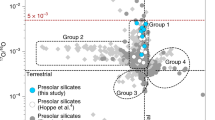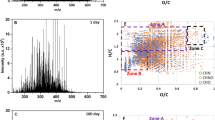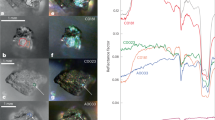Abstract
Carbonates on large Solar System bodies like Earth and Mars1,2 (the latter represented by the meteorite ALH84001) form through the weathering of silicates in a watery (CO3)2- solution. The presence of carbonates in interplanetary dust particles and asteroids (again, represented by meteorites) is not completely understood, but has been attributed to aqueous alteration on a large parent body, which was subsequently shattered into smaller pieces. Despite efforts3,4,5, the presence of carbonates outside the Solar System has hitherto not been established6,7. Here we report the discovery of the carbonates calcite and dolomite in the dust shells of evolved stars, where the conditions are too primitive for the formation of large parent bodies with liquid water. These carbonates, therefore, are not formed by aqueous alteration, but perhaps through processes on the surfaces of dust or ice grains or gas phase condensation. The presence of carbonates which did not form by aqueous alteration suggests that some of the carbonates found in Solar System bodies no longer provide direct evidence that liquid water was present on large parent bodies early in the history of the Solar System8.
This is a preview of subscription content, access via your institution
Access options
Subscribe to this journal
Receive 51 print issues and online access
$199.00 per year
only $3.90 per issue
Buy this article
- Purchase on Springer Link
- Instant access to full article PDF
Prices may be subject to local taxes which are calculated during checkout



Similar content being viewed by others
References
Mittlefehldt, D. W. ALH84001, a cumulative orthopyroxenite member of the martian meteorite clan. Meteoritics 29, 214–221 (1994).
Scott, E. R. D., Krot, A. N. & Yamaguchi, A. Carbonates in fractures of Martian meteorite Allan Hills 84001: petrologic evidence for impact origin. Meteorit. Planet. Sci. 33, 709–719 (1998).
Penman, J. M. Measurements of infrared reflectivity of astronomically interesting non-silicates. Mon. Not. R. Astron. Soc. 176, 539–545 (1976).
Gillett, F. C., Forrest, W. J. & Merrill, K. M. 8–13 micron spectra of NGC7027, BD+30°3639, and NGC6572. Astrophys. J. 183, 87–93 (1973).
Sandford, S. A. & Walker, R. M. Laboratory infrared transmission spectra of individual interplanetary dust particles from 2.5 to 25 microns. Astrophys. J. 291, 838–851 (1985).
Keane, J. V., Tielens, A. G. G. M., Boogert, A. C. A., Schutte, W. A. & Whittet, D. C. B. Ice absorption features in the 5–8 µm region toward embedded protostars. Astron. Astrophys. 376, 254–270 (2001).
Cohen, M. et al. The infrared emission bands. I. Correlation studies and the dependence on C/O ratio. Astrophys. J. 302, 737–749 (1986).
Endress, M., Zinner, E. & Bischoff, A. Early aqueous activity on primitive meteorite parent bodies. Nature 379, 701–703 (1996).
Waters, L. B. F. M. et al. Mineralogy of oxygen-rich dust shells. Astron. Astrophys. 315, L361–L364 (1996).
Jäger, C. et al. Steps toward interstellar silicate mineralogy IV. The crystalline revolution. Astron. Astrophys. 339, 904–916 (1998).
Molster, F. J. et al. Low-temperature crystallization of silicate dust in circumstellar disks. Nature 401, 563–565 (1999).
Kessler, M. F. et al. The Infrared Space Observatory (ISO) mission. Astron. Astrophys. 315, L27–L31 (1996).
Lester, D. F. & Dinerstein, H. L. An infrared disk at the center of the bipolar planetary nebula NGC 6302. Astrophys. J. 281, L67–L69 (1984).
Corradi, R. L. M. & Schwarz, H. E. The kinematics of the high velocity bipolar nebulae NGC 6537 and HB 5. Astron. Astrophys. 269, 462–468 (1993).
Gonzalez-Alfonso, E. & Cernicharo, J. The water vapor abundance in circumstellar envelopes. Astrophys. J. 525, 845–862 (1999).
Payne, H. E., Philips, J. A. & Terzian, Y. A young planetary nebula with OH molecules—NGC 6302. Astrophys. J. 326, 368–375 (1988).
Metzler, K., Bisschoff, A. & Stoeffler, D. Accretionary dust mantles in CM chondrites—Evidence for solar nebula processes. Geochim. Cosmochim. Acta 56, 2873–2897 (1992).
Pottasch, S. R. & Beintema, D. A. The ISO spectrum of the planetary nebula NGC 6302. II. Nebular abundances. Astron. Astrophys. 347, 975–982 (1999).
Rietmeijer, F. J. M. A model for diagenesis in proto-planetary bodies. Nature 313, 293–294 (1985).
Lancet, M. S. & Anders, E. Carbon isotope fractionation in the Fischer-Tropsch synthesis and in meteorites. Science 170, 980–982 (1970).
Pope, K. O., Ocampo, A. C., Fischer, A. G., Morrison, J. & Sharp, Z. Carbonate condensates in the Chicxulub ejecta deposits from Belize. Lunar Planet. Sci. 27, 1045–1046 (1996).
Molster, F. J. et al. The complete ISO spectrum of NGC6302. Astron. Astrophys. 372, 165–172 (2001).
Koike, C. et al. The spectra of crystalline silicates in infrared region. Proc. 32nd ISAS Lunar Planet. Symp. 32, 175–178 (1999).
Koike, C. et al. Absorption spectra of Mg-rich Mg-Fe and Ca pyroxenes in the mid- and far-infrared regions. Astron. Astrophys. 363, 1115–1122 (2000).
Bertie, J. E., Labbé, H. J. & Whalley, E. Absorptivity of Ice I in the range 4000-30 cm-1. J. Chem. Phys. 50, 4501–4520 (1969).
Warren, S. G. Optical constants of ice from the ultraviolet to the microwave. Appl. Opt. 23, 1206–1225 (1984).
Jäger, C., Mutschke, H., Begemann, B., Dorschner, J. & Henning, Th. Steps toward interstellar silicate mineralogy I. Laboratory results of a silicate glass of mean cosmic composition. Astron. Astrophys. 292, 641–655 (1994).
Henning, Th. & Stognienko, R. Dust opacities for protoplanetary accretion disks: influence of dust aggregates. Astron. Astrophys. 311, 291–303 (1996).
Acknowledgements
This work is based on observations with ISO, an ESA project with instruments funded by ESA member states (especially the PI countries: France, Germany, the Netherlands and the UK) and with the participation of ISAS and NASA. We thank F. J. M. Rietmeijer, D. Fabian, J. Bouwman, C. Dominik, A. G. G. M. Tielens, J. Bradley, W. Schutte, J. Keane, P. Morris, L. P. Keller, H. Y. McSween Jr and R. N. Clayton for support and discussions. We acknowledge support from an NWO ‘Pionier’ grant.
Author information
Authors and Affiliations
Corresponding author
Rights and permissions
About this article
Cite this article
Kemper, F., Jäger, C., Waters, L. et al. Detection of carbonates in dust shells around evolved stars. Nature 415, 295–297 (2002). https://doi.org/10.1038/415295a
Received:
Accepted:
Issue Date:
DOI: https://doi.org/10.1038/415295a
This article is cited by
-
A ‘dry’ condensation origin for circumstellar carbonates
Nature (2005)
-
Late Stages of Stellar Evolution
Space Science Reviews (2005)
-
Crystalline Silicates
Space Science Reviews (2005)
Comments
By submitting a comment you agree to abide by our Terms and Community Guidelines. If you find something abusive or that does not comply with our terms or guidelines please flag it as inappropriate.



